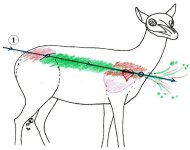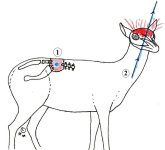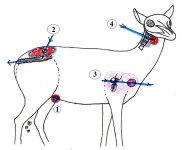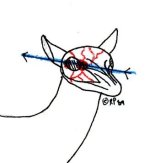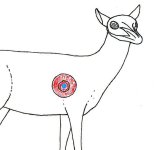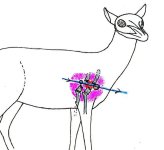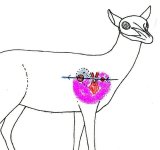FrankenMauser
New member
I've been meaning to get this ballistics report posted for a few weeks now. However, I couldn't find a good, uncopyrighted image to use as my base. So... I sketched together a 'ballpark' antelope. (Ignore the skeletonized skull. I was doing the whole antelope that way, but it interfered with some of the bullet paths. I just didn't fix the skull.)
So, here you have 3 of the 8 animals taken:
(I can't remember exact circumstances and bullet paths for most of the others. I'll get to them, if I can.)
#1 -
Animal: 2 year old Doe Pronghorn
Size: Slightly above average.
Distance: Approx. 400-425 yards.
Presentation: Facing away, laying down, level with shooter. (Until cleaning, we thought she was facing us.)
Wind: 20-25 mph crossing left-right.
Cartridge/Bullet: .270 Win. / Rem 130gr Core-Lokt (Factory load)
Outcome: Full pass through.
Time to death: less than 15 sec.
Bullet entered high, left rear quarter, hit no bones, exited quarter in opening of pelvis - 1.5" continued into digestive tract, intestines and stomach damaged severely, entered chest cavity - top of heart hit, lungs shredded, exploded 1 rib upon exit of animal on right side of chest. Approx 1.75" exit wound. Whether it was the bullet, or the animal tensing up... there was a spray of intestinal and stomach contents all over the sagebrush - inline with the exit wound.
Animal jumped up after impact, spun 360 degrees, fell. Her head bounced into a bush, and never twitched again. (More lung-tainted 'poop' pushed out of entrance and exit wounds.)
Not even a bullet fragment recovered.

#2 -
Animal: Fawn Pronghorn.
Size: Average for a Fawn.
Distance: Approx. 80-90 yards.
Presentation: Broadside, facing right, dead run, 10-15' above shooter.
Wind: Very strong, 30-40 mph, crossing right to left
Cartridge/Bullet: .270 Win. / Rem 130gr Core-Lokt (Factory load)
Outcome: Devastating
Time to death: ~90 seconds
I think I stopped swinging the rifle, upon pulling the trigger; rather than following through with the running animal. Bullet impacted high on the back, just forward of hind quarters. (Rather than the chest I was leading and providing windage for.) Bullet entered backstrap, struck the spinal column, and absolutely exploded the spine, backstrap, tenderloins, and a few inches of the forward pelvis; even on the entry side. There was a 5" hole, from one side to the other. The animal was pretty much dead, but a finisher was put into the bottom of its chin; exiting through the center of the skull top. (Messy)
Not even a bullet fragment recovered.

#3 -
Animal: 1 year old Buck Pronghorn (No cheek patch, tiny horns. Thought he was a Doe.)
Size: Average.
Distance: Approx. 350-400 yards.
Presentation: Broadside, facing left, 75-100 feet below shooter. (running right to left for shots 2+3, finisher for 4)
Wind: 20-25 mph, slightly quartering toward us, crossing left to right. (for first 2 shots. Second 2 shots were after a chase.)
Cartridge/Bullet: .270 Win. / Speer 100gr Hollow Point.(Handload) - .270 Win. / Rem 130gr Core-Lokt (Factory load) - 9mm 124gr Gold Dot HP
Outcome: Interesting...
Time to death: 5-10 min.
Bullet 1: 130gr Core-Lokt... Dropped and drifted farther than shooter anticipated, entered front of left rear leg, above knee, under skin, did not enter muscle; continued under skin, across bottom of belly, between penis and belly (didn't hurt it); entered right leg, under skin, did not touch muscle, exited skin with caliber-size wound.
Bullet 2: We lose track of the animal, as the herd bugs out. We see a
Doe in the back of the herd, with a strange hobble; although still running quite fast. Animal is moving at approx 35-45 mph, right to left, gaining elevation, positioned so only one shooter can fire. A 100gr HP (intended for head shots) happens to be in that shooter's chamber. He decides we should take that Doe, and fires an anchoring shot. (Trying for a broken front shoulder and possible heart shot, but knows the bullet is unlikely to penetrate.)
Bullet hits high on left rear hind quarter. Massive damage to meat and bone. Bullet and fragments enter Anal Cavity via one of the holes in the pelvis and are "eliminated" by animal.
Bullet 3: 130gr Core-Lokt Animal runs to approx 600-700 yards, and lays down. We slowly close the distance to 100-150 yards. Animal jumps up, and hits a dead run; broadside, 35-40 mph, right to left, wind behind us, level with shooter.
Bullet enters center of shoulder, left side, breaks bone, shreds lungs, minor damage to heart, exits between ribs, right side, forward of shoulder, 1.5" exit wound.
Bullet 4: Animal still not dead upon reaching him. Finisher put into spine, at base of skull. 9mm, 124gr Gold Dot HP. Bullet passed through at least 75% of neck thickness; did not exit.
No bullets recovered. No fragments found. (We forgot about the Gold Dot until after the butchered carcass was gone.)

Oh... for the record....
We had all kinds of Factory and Handloaded ammo on the hunt. Everything from Bear Claws, to Fail Safes, to Ballistic Tips, to Partitions, to frangible hollow points. It just worked out that we used Core-Lokts for almost every shot that counted.
I don't know about my brothers, but my faith in the Core-Lokt was made that much stronger. It's an "outdated" design, but it sure does kill stuff just as dead.
So, here you have 3 of the 8 animals taken:
(I can't remember exact circumstances and bullet paths for most of the others. I'll get to them, if I can.)
#1 -
Animal: 2 year old Doe Pronghorn
Size: Slightly above average.
Distance: Approx. 400-425 yards.
Presentation: Facing away, laying down, level with shooter. (Until cleaning, we thought she was facing us.)
Wind: 20-25 mph crossing left-right.
Cartridge/Bullet: .270 Win. / Rem 130gr Core-Lokt (Factory load)
Outcome: Full pass through.
Time to death: less than 15 sec.
Bullet entered high, left rear quarter, hit no bones, exited quarter in opening of pelvis - 1.5" continued into digestive tract, intestines and stomach damaged severely, entered chest cavity - top of heart hit, lungs shredded, exploded 1 rib upon exit of animal on right side of chest. Approx 1.75" exit wound. Whether it was the bullet, or the animal tensing up... there was a spray of intestinal and stomach contents all over the sagebrush - inline with the exit wound.
Animal jumped up after impact, spun 360 degrees, fell. Her head bounced into a bush, and never twitched again. (More lung-tainted 'poop' pushed out of entrance and exit wounds.)
Not even a bullet fragment recovered.
#2 -
Animal: Fawn Pronghorn.
Size: Average for a Fawn.
Distance: Approx. 80-90 yards.
Presentation: Broadside, facing right, dead run, 10-15' above shooter.
Wind: Very strong, 30-40 mph, crossing right to left
Cartridge/Bullet: .270 Win. / Rem 130gr Core-Lokt (Factory load)
Outcome: Devastating
Time to death: ~90 seconds
I think I stopped swinging the rifle, upon pulling the trigger; rather than following through with the running animal. Bullet impacted high on the back, just forward of hind quarters. (Rather than the chest I was leading and providing windage for.) Bullet entered backstrap, struck the spinal column, and absolutely exploded the spine, backstrap, tenderloins, and a few inches of the forward pelvis; even on the entry side. There was a 5" hole, from one side to the other. The animal was pretty much dead, but a finisher was put into the bottom of its chin; exiting through the center of the skull top. (Messy)
Not even a bullet fragment recovered.
#3 -
Animal: 1 year old Buck Pronghorn (No cheek patch, tiny horns. Thought he was a Doe.)
Size: Average.
Distance: Approx. 350-400 yards.
Presentation: Broadside, facing left, 75-100 feet below shooter. (running right to left for shots 2+3, finisher for 4)
Wind: 20-25 mph, slightly quartering toward us, crossing left to right. (for first 2 shots. Second 2 shots were after a chase.)
Cartridge/Bullet: .270 Win. / Speer 100gr Hollow Point.(Handload) - .270 Win. / Rem 130gr Core-Lokt (Factory load) - 9mm 124gr Gold Dot HP
Outcome: Interesting...
Time to death: 5-10 min.
Bullet 1: 130gr Core-Lokt... Dropped and drifted farther than shooter anticipated, entered front of left rear leg, above knee, under skin, did not enter muscle; continued under skin, across bottom of belly, between penis and belly (didn't hurt it); entered right leg, under skin, did not touch muscle, exited skin with caliber-size wound.
Bullet 2: We lose track of the animal, as the herd bugs out. We see a
Doe in the back of the herd, with a strange hobble; although still running quite fast. Animal is moving at approx 35-45 mph, right to left, gaining elevation, positioned so only one shooter can fire. A 100gr HP (intended for head shots) happens to be in that shooter's chamber. He decides we should take that Doe, and fires an anchoring shot. (Trying for a broken front shoulder and possible heart shot, but knows the bullet is unlikely to penetrate.)
Bullet hits high on left rear hind quarter. Massive damage to meat and bone. Bullet and fragments enter Anal Cavity via one of the holes in the pelvis and are "eliminated" by animal.
Bullet 3: 130gr Core-Lokt Animal runs to approx 600-700 yards, and lays down. We slowly close the distance to 100-150 yards. Animal jumps up, and hits a dead run; broadside, 35-40 mph, right to left, wind behind us, level with shooter.
Bullet enters center of shoulder, left side, breaks bone, shreds lungs, minor damage to heart, exits between ribs, right side, forward of shoulder, 1.5" exit wound.
Bullet 4: Animal still not dead upon reaching him. Finisher put into spine, at base of skull. 9mm, 124gr Gold Dot HP. Bullet passed through at least 75% of neck thickness; did not exit.
No bullets recovered. No fragments found. (We forgot about the Gold Dot until after the butchered carcass was gone.)
Oh... for the record....
We had all kinds of Factory and Handloaded ammo on the hunt. Everything from Bear Claws, to Fail Safes, to Ballistic Tips, to Partitions, to frangible hollow points. It just worked out that we used Core-Lokts for almost every shot that counted.
I don't know about my brothers, but my faith in the Core-Lokt was made that much stronger. It's an "outdated" design, but it sure does kill stuff just as dead.
Attachments
Last edited:

